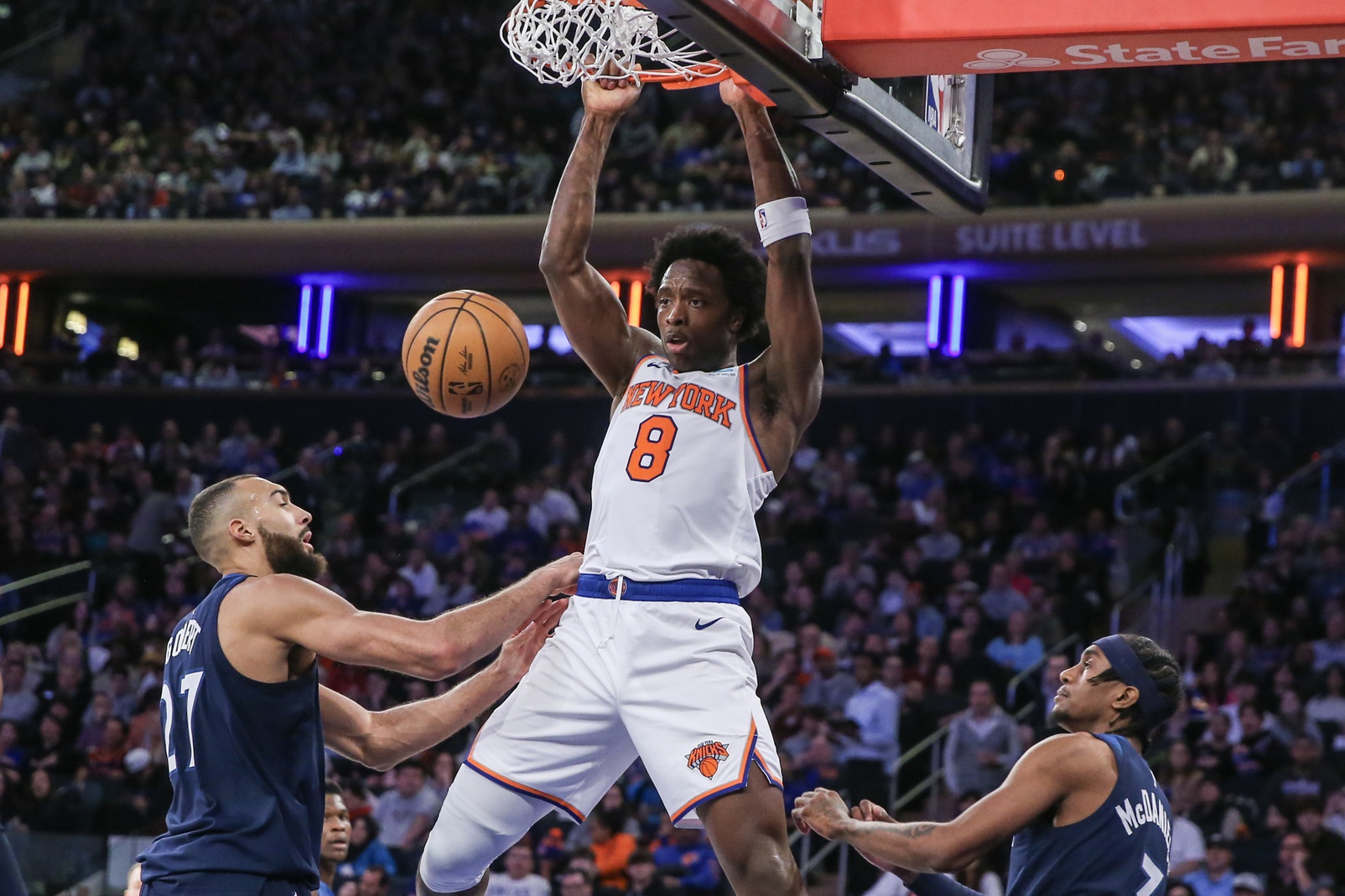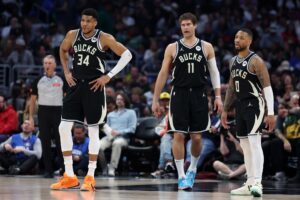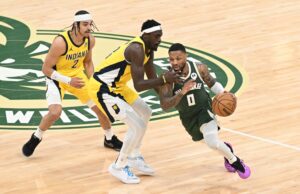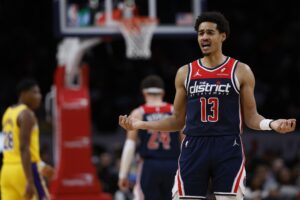In a shocking but bold move, the New York Knicks pulled off a huge trade with the Toronto Raptors, acquiring heavily sought-after wing OG Anunoby. Here’s the deal in full:
Raptors receive RJ Barrett, Immanuel Quickley, and a 2024 second-round pick from the Detroit Pistons.
Knicks receive Anunoby, Precious Achiuwa, and Malachi Flynn.
5 Takeaways From the Knicks’ Blockbuster Trade
Anunoby was one of the names that most contending teams wanted to get their hands on. This is due to his elite ability to space the floor, defend all five positions, and knock down corner threes. This was a position the Knicks desperately needed to upgrade. Meanwhile, the Raptors needed a starting point guard and an ideal partner for Scottie Barnes. They landed that with Quickley, who is undoubtedly the aspect of the deal which will be regrettable for the Knicks. Nevertheless, this deal is a potential win for both sides, particularly the Knicks.
1. Anunoby Makes the Knicks Better Now and in the Future
Anunoby is the ideal fit for the Knicks’ defensive identity. They were crying out for someone in their lineup with a huge seven-foot wingspan and an elite wing defender who doesn’t need the ball to be effective. Not only that but someone who knocks down corner threes at a high clip. Anunoby is all of the above. He can defend all five positions at an elite level; the perennial All-NBA defense is someone the Knicks have wanted for a long time.
Furthermore, judging by Anunoby changing agents to CAA (president Leon Rose’s former agency), presumably, he wanted to facilitate the move himself. Expect him to extend his contract with the Knicks for a mutually beneficial long-term contract. He’s only 26, so this makes sense for both parties.
As mentioned earlier, the roster construction of being over-saturated with guards, with a lack of size, led them to be fodder against the bigger teams in the league. The Orlando Magic had their way with them last week, and it was becoming a problem. Especially with Mitchell Robinson’s injury, the Knicks went from being one of the best defensive teams to the worst in short order. This move addresses this.
Furthermore, Achiuwa can handle the backup four and five spots. The Knicks had no backup to Julius Randle or Isaiah Hartenstein on the floor; Achiuwa addresses this nicely.
Anunoby was third in the NBA in deflections last year but is not just a defensive wizard. Offensively, he cuts to the rim for easy dunks, moves off the ball excellently, and knocks down around 47% of his corner threes for his career.
This helps the Knick’s defense, spacing, and efficiency on the floor.
Judging by New York’s last two games, Anunoby appears the perfect fit. He’s had a winning start to his new team, notching an incredible +54 rating. He’s also shooting 12/21 and 40% from three while averaging seven rebounds and two steals.
He fits the profile of what the Knicks are looking for and, above all, gives them a defensive identity that suits a Thibodeau team.
2. Anunoby Makes Randle and Brunson Better
An underrated aspect of this trade is the improved spacing on the floor for Jalen Brunson and Randle.
Barrett’s only real asset is his ability to drive to the cup. Incidentally, this is Randle’s best asset, while Brunson also does most of his damage there. Barrett, as a solely left-handed finisher with an inefficient jumper, tended to occupy the same spots on the floor that Randle did, affecting floor spacing. It often looked like they took turns dominating the ball. It led to far too many isolation possessions and a clunky half-court offense.
Randle is a force down low. Few in the NBA can match his dominance in the paint. Adding Anunoby spaces the floor and opens the paint for Randle to do his best work.
In turn, Randle has gone off for 39 and 35 points in his last two games with Anunoby. For the year, Randle is putting up All-Star-worthy numbers of 24.4 points, 9.5 rebounds and 4.7 assists. This level of scoring should continue with the increased spacing on the court.
Another player who benefits is Brunson. With this spacing, he is becoming a better playmaker. Brunson, over his last two games, has 27 assists. He notched a career-high 14 assists against the Minnesota Timberwolves and had a 31-point, 13-assist effort against the Bulls. Brunson can now facilitate the offense and has more lanes in the paint to continue to dominate.
Randle and Brunson will improve on their already All-Star numbers.
3. The Knicks Are Better Without Barrett, and Vice Versa
No disrespect to a player who provided some quality moments for the Knicks, but he wasn’t an ideal fit due to his inefficency. His low field goal percentage of 42.5% is 347th in the league. Meanwhile, his crafted defensive plus-minus was in the fifth percentile (per Crafted NBA.) Thus, his contribution on the floor was a net minus.
Since the deal, the increased movement and spacing on the court have been much improved. Donte DiVincenzo and Anunoby are efficient perimeter shooters, as is Brunson, with Hartenstein proving phenomenal minutes on both ends beside Randle. With better defense, the Knicks are playing faster in transition, leading to easier buckets and fast break points.
Barrett should also benefit from a change. He gets to go home to Canada and play for the Raptors. He fits better in a lineup alongside Barnes, Quickley, and Pascal Siakam. Barrett also has a knack for knowing when to attack the paint and score at the rim.
4. The Knicks Will Regret Trading Quickley
The Raptors have gained a heck of a player in Quickley. He is a tremendous microwave scorer, able to score on all three levels. He also creates off the dribble and can defend both guard positions at a high level.
CBS Sports will surely be smarting at grading the Knicks’ original draft selection of Quickley as a D+. Consistently, Quickley was their third-best player on the roster.
Quickley has perfect shooting mechanics. He has a quick release and an ability from the pick-and-roll to knock down step-back threes from the perimeter. He also beats his man off the dribble and knocks down floaters in the paint at a very high percentage.
He’s gotten off to a great start in Toronto, too. He scored 26 points and five assists against the Grizzlies, and Raptor fans will love him. They needed a lead guard, and he’s showing he just needed that opportunity.
It’s surprising New York didn’t consider him as a starting guard besides Brunson. Quickley averages 15.3 points and 40.6% from three in just 24.4 minutes a night.
According to StatMuse, he’s averaging 22.5 points per 36 minutes and a +137 rating on the court. These are crazy numbers showing what he can do with increased playing time. Statistically, when Quickley and Brunson played together, they excelled.
It’s a mistake the Knicks let this man go. He’s been indisputably the best Knicks first-round pick in memory, and the Raptors have gained a real talent.
5. The Knicks Still Need Another Scorer to Be Considered Elite
With Quickley going the other way, they are now short of scoring off the bench. Furthermore, they lost their only ball-handler other than Brunson.
At the trade deadline, they could explore a deal for Jordan Clarkson, who is averaging 17.8 points for the year.
Malcolm Brogdon would also make sense, averaging 15.7 points on 43.8% shooting and 41.4% from three. The Portland Trail Blazers will likely be more amenable to a trade to continue their rebuild. Brogdon can also defend his position when called upon, so he would fit Thibodeau’s system.
The Knicks have many assets – Evan Fournier’s expiring contract allows them to match higher salaries while still having a ton of first-round picks at their disposal. They also have Quentin Grimes as a trade asset. Moving off Barrett’s contract has also allowed the Knicks more salary cap flexibility.
Of course, if the Knicks really wish to challenge the Eastern Conference title, they should call Cleveland and convince them to trade Donovan Mitchell before he leaves as a free agent in 2025. Currently, the only way I can see the salaries match is to include Robinson in a deal with Grimes and Fournier. Before his surgery, Robinson was the best offensive rebounder in the NBA and heading for an All-Defense nod. Having said that, Hartenstein is playing extremely well for the Knicks right now. In his last game against the Bulls, he had 20 rebounds, 10 points, and five blocks.
Alternatively, the Knicks could make a smaller move at the deadline, opt for Brogdon/Clarkson, and revisit Mitchell in the offseason, perhaps without including Robinson.
All in all, the Knicks took a step forward. They will likely regret trading Quickley yet put themselves on the path toward being one of the top teams in the East. With a softer January schedule, expect the Knicks to be back among the top five teams in the East.
Why Did the Knicks Part Ways With Their Draft Talents?
First, Barrett and Quickley contributed to helping navigate the Knicks out of the doldrums and into regular playoff contention. They carried themselves professionally on and off the court.
That being said, both players contractual situations played a part in their being traded, as well as the teams’ present roster construction.
As good as Quickley has been, his minutes were dropping this year through no fault of his own. Over-saturated at guard, head coach Tom Thibodeau had to find a role for everyone. DiVincenzo has been in excellent form since his free-agent signing. Josh Hart, the quintessential ‘glue guy,’ got re-upped this offseason after being a key part in their playoff run last year.
All players, including Grimes, were vying to play beside point guard star Brunson. This wasn’t a sustainable situation.
Nevertheless, the real reason Quickley was traded was his impending restricted free agency. The possibility of rejecting New York’s contract offer in the offseason likely made a deal inevitable. So, the Knicks had to move him now instead of losing him for nothing.
As for Barrett, the Knicks showed faith in him by extending him instead of trading him for Mitchell two summers ago. Since the hefty extension, his development plateaued, his efficiency dropped massively, and his contract became a negative asset. Above all, he was playing as an undersized forward. Plus, his game didn’t ideally mesh with Randle and Brunson.






